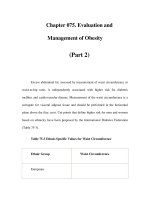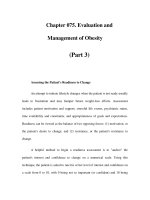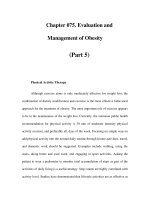Chapter 104. Acute and Chronic Myeloid Leukemia (Part 5) docx
Bạn đang xem bản rút gọn của tài liệu. Xem và tải ngay bản đầy đủ của tài liệu tại đây (15.36 KB, 6 trang )
Chapter 104. Acute and Chronic
Myeloid Leukemia
(Part 5)
Morphology of AML cells. A. Uniform population of primitive
myeloblasts with immature chromatin, nucleoli in some cells, and primary
cytoplasmic granules. B. Leukemic myeloblast containing an Auer rod. C.
Promyelocytic leukemia cells with prominent cytoplasmic primary granules. D.
Peroxidase stain shows dark blue color characteristic of peroxidase in granules in
AML.
Platelet counts <100,000/µL are found at diagnosis in ~75% of patients, and
about 25% have counts <25,000/µL. Both morphologic and functional platelet
abnormalities can be observed, including large and bizarre shapes with abnormal
granulation and inability of platelets to aggregate or adhere normally to one
another.
Pretreatment Evaluation
Once the diagnosis of AML is suspected, a rapid evaluation and initiation
of appropriate therapy should follow (Table 104-2). In addition to clarifying the
subtype of leukemia, initial studies should evaluate the overall functional integrity
of the major organ systems, including the cardiovascular, pulmonary, hepatic, and
renal systems. Factors that have prognostic significance, either for achieving
complete remission (CR) or for predicting the duration of CR, should also be
assessed before initiating treatment. Leukemic cells should be obtained from all
patients and cryopreserved for future use as new tests and therapeutics become
available. All patients should be evaluated for infection.
Table 104-
2 Initial Diagnostic Evaluation and Management of Adult
Patients with Acute Myeloid Leukemia
History
Increasing fatigue or decreased exercise tolerance (anemia)
Excess bleeding or bleeding from unusual sites (DIC, thrombocytopenia)
Fevers or recurrent infections (granulocytopenia)
Headache, vision changes, nonfocal neurologic abnormalities (CNS
leukemia or bleed)
Early satiety (splenomegaly)
Family history of AML (Fanconi, Bloom, or Kostmann syndromes or
ataxia telangiectasia)
History of cance
r (exposure to alkylating agents, radiation, topoisomerase
II inhibitors)
Occupational exposures (radiation, benzene, petroleum products, paint,
smoking, pesticides)
Physical Examination
Performance status (prognostic factor)
Ecchymosis and oozing from I
V sites (DIC, possible acute promyelocytic
leukemia)
Fever and tachycardia (signs of infection)
Papilledema, retinal infiltrates, cranial nerve abnormalities (CNS leukemia)
Poor dentition, dental abscesses
Gum hypertrophy (leukemic infiltration, most commo
n in monocytic
leukemia)
Skin infiltration or nodules (leukemia infiltration, most common in
monocytic leukemia)
Lymphadenopathy, splenomegaly, hepatomegaly
Back pain, lower extremity weakness [spinal granulocytic sarcoma, most
likely in t(8;21) patients]
Laboratory and Radiologic Studies
CBC with manual differential cell count
Chemistry tests (electrolytes, creatinine, BUN, calcium, phosphorus, uric
acid, hepatic enzymes, bilirubin, LDH, amylase, lipase)
Clotting studies (prothrombin time, partial thromb
oplastin time, fibrinogen,
D-dimer)
Viral serologies (CMV, HSV-1, varicella zoster)
RBC type and screen
HLA typing of patient, siblings, and parents for potential allogeneic SCT
Bone marrow aspirate and biopsy (morphology, cytogenetics, flow
cytometry, molecular studies)
Cryopreservation of viable leukemia cells
Echocardiogram or heart scan
PA and lateral chest radiograph
Placement of central venous access device
Interventions for Specific Patients
Dental evaluation (for those with poor dentition)
Lumbar puncture (for those with symptoms of CNS involvement)
Screening spine MRI (for patients with back pain, lower extremity
weakness, paresthesias)
Social work referral for patient and family psychosocial support
Counseling for All Patients
Provide patient w
ith information regarding his/her disease, financial
counseling, and support group contacts
Abbreviations:
BUN, blood urea nitrogen; CBC, complete blood count;
CMV, cytomegalovirus; CNS, central nervous system; DIC, disseminated
intravascular coagulatio
n; HLA, human leukocyte antigen; HSV, herpes simplex
virus; LDH, lactate dehydrogenase; MRI, magnetic resonance imaging; PA,
posteroanterior; RBC, red blood (cell) count; SCT, stem cell transplant.









